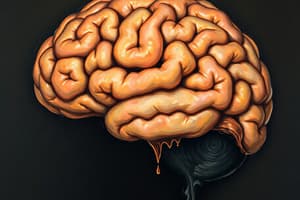Podcast
Questions and Answers
What cognitive ability is defined as the capacity to adapt thinking and behavior?
What cognitive ability is defined as the capacity to adapt thinking and behavior?
Which Brodmann Area is primarily associated with motor speech programming?
Which Brodmann Area is primarily associated with motor speech programming?
Which cognitive process is defined as the ability to repress inappropriate responses?
Which cognitive process is defined as the ability to repress inappropriate responses?
What area is primarily responsible for language comprehension?
What area is primarily responsible for language comprehension?
Signup and view all the answers
Which section is related to left-right disorientation and finger agnosia?
Which section is related to left-right disorientation and finger agnosia?
Signup and view all the answers
What does a higher score indicate in the context of brain function assessment?
What does a higher score indicate in the context of brain function assessment?
Signup and view all the answers
Which area is NOT evaluated when assessing functional independence?
Which area is NOT evaluated when assessing functional independence?
Signup and view all the answers
What should physical therapists focus on when assessing consciousness in patients?
What should physical therapists focus on when assessing consciousness in patients?
Signup and view all the answers
Which of the following best describes the goals of physical therapy approaches mentioned?
Which of the following best describes the goals of physical therapy approaches mentioned?
Signup and view all the answers
What does the Functional Independence Measure evaluate?
What does the Functional Independence Measure evaluate?
Signup and view all the answers
What behavior is noted in a patient experiencing severe agitation?
What behavior is noted in a patient experiencing severe agitation?
Signup and view all the answers
What is a common characteristic of RLA Level 5?
What is a common characteristic of RLA Level 5?
Signup and view all the answers
Which strategy is recommended for helping a patient who struggles with attention and recall?
Which strategy is recommended for helping a patient who struggles with attention and recall?
Signup and view all the answers
What behavior might indicate decreased initiation in a patient?
What behavior might indicate decreased initiation in a patient?
Signup and view all the answers
When interacting with a patient at this level, which approach should be avoided?
When interacting with a patient at this level, which approach should be avoided?
Signup and view all the answers
What is a typical sign of disorientation in a patient?
What is a typical sign of disorientation in a patient?
Signup and view all the answers
What is a recommended approach when explaining a change in activity for the patient?
What is a recommended approach when explaining a change in activity for the patient?
Signup and view all the answers
What does poor day-to-day recall in a patient indicate?
What does poor day-to-day recall in a patient indicate?
Signup and view all the answers
What is the primary goal when engaging both the patient and caregiver during therapy?
What is the primary goal when engaging both the patient and caregiver during therapy?
Signup and view all the answers
Which stimulus should be applied if the patient shows eye opening?
Which stimulus should be applied if the patient shows eye opening?
Signup and view all the answers
What is crucial to ensure during the therapy session to minimize distractions?
What is crucial to ensure during the therapy session to minimize distractions?
Signup and view all the answers
What should be done with the patient's hair during therapy to prevent issues?
What should be done with the patient's hair during therapy to prevent issues?
Signup and view all the answers
What is the expected patient response to any applied stimulus at RLA 2?
What is the expected patient response to any applied stimulus at RLA 2?
Signup and view all the answers
What should be removed from the patient's body before engaging in therapy?
What should be removed from the patient's body before engaging in therapy?
Signup and view all the answers
What action is essential for documentation during therapy sessions?
What action is essential for documentation during therapy sessions?
Signup and view all the answers
What should be done if there is restlessness and agitation preventing the assessment of range of motion (ROM)?
What should be done if there is restlessness and agitation preventing the assessment of range of motion (ROM)?
Signup and view all the answers
What is the purpose of the 6-minute walk test?
What is the purpose of the 6-minute walk test?
Signup and view all the answers
Which assessment would be used if a patient is unable to follow instructions?
Which assessment would be used if a patient is unable to follow instructions?
Signup and view all the answers
What does a poor score on the Glasgow Coma Scale (GCS) indicate?
What does a poor score on the Glasgow Coma Scale (GCS) indicate?
Signup and view all the answers
What does the WeeFIM assess in younger children?
What does the WeeFIM assess in younger children?
Signup and view all the answers
Why is it important to assess a patient's tolerance to the upright position?
Why is it important to assess a patient's tolerance to the upright position?
Signup and view all the answers
What does decerebrate posturing indicate?
What does decerebrate posturing indicate?
Signup and view all the answers
What is an indicator of a poorer prognosis regarding pupillary responses?
What is an indicator of a poorer prognosis regarding pupillary responses?
Signup and view all the answers
Which assessment method focuses on documenting progress from coma to community?
Which assessment method focuses on documenting progress from coma to community?
Signup and view all the answers
Which type of range of motion must be executed carefully to avoid pain?
Which type of range of motion must be executed carefully to avoid pain?
Signup and view all the answers
In functional assessment, which aspect indicates a patient's independence in ADLs?
In functional assessment, which aspect indicates a patient's independence in ADLs?
Signup and view all the answers
What does the assessment of gait include?
What does the assessment of gait include?
Signup and view all the answers
What does the Functional Motor Test (FMT) observe?
What does the Functional Motor Test (FMT) observe?
Signup and view all the answers
What might imaging results show if they indicate a poorer prognosis?
What might imaging results show if they indicate a poorer prognosis?
Signup and view all the answers
What role does assessing balance play in functional assessment?
What role does assessing balance play in functional assessment?
Signup and view all the answers
Study Notes
Cognitive Flexibility and Brain Areas
- Cognitive flexibility refers to the ability to adapt thinking and behavior.
- Total of 52 Brodmann Areas (BAs) involved in various cognitive functions.
Key Brain Areas
- BA 312: Primary somatosensory area.
- BA 4, 6: Involved in primary motor, premotor, and supplementary motor functions.
- BA 44, 45: Broca’s Area, essential for motor speech programming.
- BA 17: Primary visual cortex.
- BA 22: Auditory processing, includes Wernicke's area for language comprehension.
- BA 39, 40: Gerstmann syndrome related to left-right disorientation, finger agnosia, agraphia, and acalculia.
Cognitive Assessment in PT
- Assess cognitive functions during neurological examinations based on patient complaints.
Range of Motion (ROM) Assessment
- Passive Range of Motion (PROM): Must avoid inducing stretching pain on tight muscles and joints.
- Active Range of Motion (AROM): Conducted if the patient can follow instructions.
- Manual Muscle Testing (MMT): Usual assessment method if patient can respond.
- Functional Muscle Testing (FMT): Used if patient is unresponsive, assessing motor responses.
Prognosis Indicators
- Poor prognosis if Glasgow Coma Scale (GCS) is less than 7, or post-traumatic amnesia (PTA) exceeds 2 weeks.
- Imaging (CT scans) shows worse outcomes with large blood clots.
- Age impacts recovery capacity.
- Pupillary responses indicate prognosis; dilated pupils suggest poor outcomes while constriction suggests severe brain involvement.
Functional Assessment Tools
- Disability Rating Scale: Rates participation restriction and tracks recovery from coma to community reintegration.
- Functional Independence Measure (FIM): Measures mobility, ADL function, cognition, and communication.
RLA Levels of Recovery
- RLA Level 1: No response; focus on passive assessments and signs of consciousness.
- RLA Level 2: Slight response to stimuli; generalized reflex responses noted.
- RLA Level 5: Confused and inappropriate responses; caregivers should be involved for structured support.
Management Strategies
- Step-by-step commands and repetition are crucial in managing cognitive impairments.
- Maximize structure to assist with familiar tasks.
- Engage caregivers and family members; communication should accommodate the patient's cognitive level.
Gait and Postural Assessments
- Gait assessed for independence, surface, distance, and assistive device (AD) usage.
- Postural evaluations for abnormal postures like decerebrate or decorticate posturing.
Important Considerations for Therapy
- Monitor cardiovascular endurance through the 6-minute walk test.
- Document findings meticulously, especially in cases of agitation or unresponsiveness.
- Focus on patient tolerance to upright positions, tracking vital signs during position changes.
Studying That Suits You
Use AI to generate personalized quizzes and flashcards to suit your learning preferences.
Related Documents
Description
This quiz explores the concept of cognitive flexibility and its relation to behavior analysis, focusing on key areas such as initiation, self-generation, and response inhibition. Dive into the principles that govern adaptability in thinking and behavior as covered in BA courses. Assess your understanding of these psychological functions and their applications.




